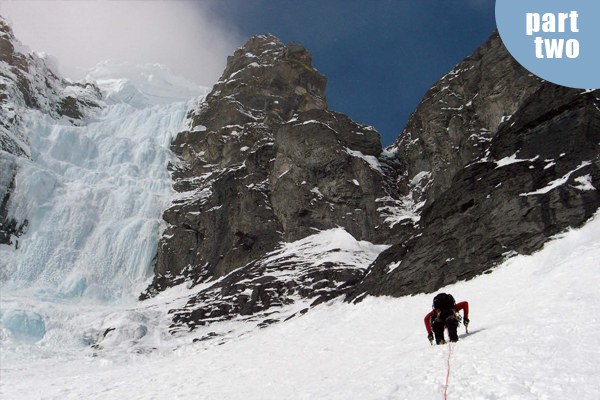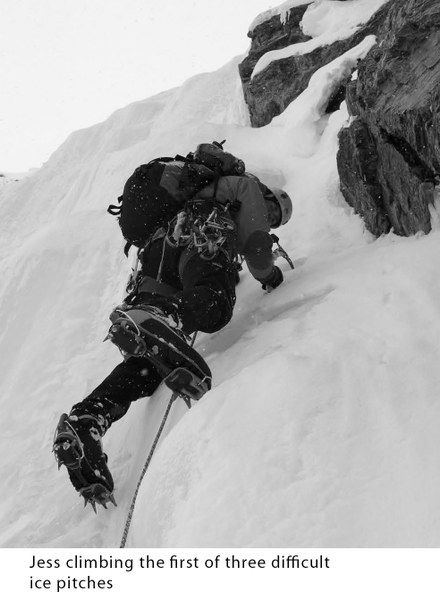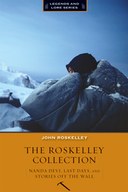
SLIPSTREAM, part 2
BY JOHN ROSKELLEY
Excerpted from The Roskelley Collection, in memory of Jess Roskelley. (See Part 1 and Part 3)
The difficult pitch had taken Jess an hour to lead. He had willed himself to overcome frozen hands and poor protection to finally reach a belay point. After a full hour of freezing down below, I wasn’t sure I could follow. I removed the belay screws and yelled, “Climbing!” The rope pulled on my harness and I started up, my hands encased in frozen gloves as I tried to move fast enough to stop shivering.
Once to his belay, I stammered out the words I never thought I would utter in my mountaineering career. “You’re going to have to lead the next pitch. I’m too cold.”
Even though I had managed to climb the pitch without help, my hands were like dead wood. Not only were my hands without feeling, spindrift from the continual avalanches coming down the route had snuck into the neck opening of my jacket as it bounced and flew down the ice, leaving me as hypothermic as if I’d just stepped from an icy pond.
Given how hard it was for me to admit that I couldn’t lead the next pitch, I can’t imagine what Jess was thinking upon hearing those words. But he didn’t flinch.
“All right. Do you need some food or water?”
“I’ll grab something while you lead the pitch. Just don’t take too long,” I replied.
Jess climbed steadily for twenty feet, placed a pin, and then moved right, to where the frozen waterfall dropped in vertical steps as it made its way along the rock wall. Once again, where I had thought my belay stance was protected from spindrift and tool-displaced ice, his route put him directly over me and I became the target of all things hard and cold. More ice screws; more time. Jess overprotected the pitch, but the ice was pocketed and several of his placements were “prayer pins” at best. He disappeared from view, and only a slight, agonizingly slow upward movement of the rope convinced me that he was still moving.
We were now smothered in cloud. As is often the case with big alpine walls, the wind was blowing from every direction, including from below. Visibility was down to one hundred feet. What were light winds to us on the east face, though, was a howling tempest at the top of Slipstream on Mount Snowdome’s summit. These winds deposited snow in the basin five hundred feet above us and below the ice-capped summit. From this catch basin, spindrift avalanches broke loose and poured down around us and upon us. Menacingly, the massive cornice that crowns Mount Snowdome was now in perspective, and we could see it overhanging Slipstream like the prow of an aircraft carrier.
“Belay on!” Jess yelled from above.
When it came time for me to follow, my hands couldn’t function well enough to use my ice tools. I attached my jumars to the rope with short slings and hollered at Jess for him to secure the rope to the belay anchors. He did so, and I began pulling myself up the rope using the two jumars for my hands and trying to get a bite of the ice with the front points of my crampons. The process proved more difficult than just climbing the pitch with my tools. Every time I pulled on the rope and stepped up, my front points, lacking the necessary body weight to hold on to the ice, slipped out from under me. My hands quickly lost all feeling. I stopped after every few moves, removed my hands from the jumars, lowered them to my sides, and shook them until some feeling came back. After thirty minutes of agonizing struggle, I reached the belay. Jess didn’t want to lead again, but he didn’t have a choice. I couldn’t get my hands warm enough to use ice tools and place protection. I was beginning to get warmer, though. At the last belay, I managed to put on my down coat, which improved my mental state considerably, from cold-induced mental defeat to “we might get off this face.” At this point, the safest direction was toward the summit. We either climbed up and over the top, or faced the extremely difficult task of safely descending 2500 feet under severe avalanche conditions to return to camp.
 Thirty feet up the eighty-five-degree ice of the next lead, Jess stopped to put in his third ice screw. Frustrated at not being able to get one in after several attempts, he yelled down to me and asked if I wanted to lead the pitch.
Thirty feet up the eighty-five-degree ice of the next lead, Jess stopped to put in his third ice screw. Frustrated at not being able to get one in after several attempts, he yelled down to me and asked if I wanted to lead the pitch.
He must be hallucinating, I thought. “No,” I replied. I still didn’t have feeling in my hands.
This is when I said to him, “Jess, you’ve got to move faster,” and then added, “Or we’re going to die right here.” I had been looking for a place to bivouac for hours, and there was not a ledge large enough to sit on or a snow slope that looked suitable for a bivouac on the upper face. I’m sure we could have stomped our feet and shook our arms through the night to survive, but this was an alternative we hoped to avoid.
The character of climbers cannot be judged by what they can do at the start of a climb, when their blood is hot and flows like a river and their energy is bursting from their pores. It’s at the end, when they can no longer grip their ice tools, their mouth feels as if it’s full of chalk, and their gut tells them that now the odds favor the mountain, not them.
Jess’s character rose to the top. He finished off the 180-foot pitch in the fading light and called for me to follow. More rested and warm than I had been just an hour earlier, I climbed the long ice pitch quickly, taking out the two ice screws above my belay and the single ice screw Jess had placed three-quarters of the way to his belay. It was a magnificent lead, despite spindrift avalanches, pocketed ice conditions, and my incessant urging for more speed.
“I can take the next lead,” I said. “My hands are back and I’m feeling stronger.”
I grabbed a few ice screws from Jess’s harness and led the steep ice steps above the belay. I was soon out of sight, moving quickly over moderate terrain. Within fifteen minutes I reached the end of the rope, placed several belay screws, and then yelled to Jess to start climbing. After ten minutes, he planted his second tool in the ice next to me at the belay, just as any semblance of light disappeared on the western horizon.
The summit loomed above us in the starlight, seemingly a stone’s throw away, but our hopes of reaching it that day faded as night blanketed the peak.
“I’ll lead up to the ridge,” he offered. “That’ll get us out of the gully.”
Jess waded waist deep in sixty-degree snow from the belay up the right side of the snow basin perched above Slipstream. After 150 feet, he reached the arête that separates Mount Snowdome’s east and north faces. Once on the arête, he kicked out a small stance and belayed me to him.
It was close to midnight when I reached Jess. The clouds had departed and along with them, the wind. Now that we were stopped, we were aware that the air temperature, under clear, starry skies, was falling rapidly. Two hundred feet above us was the summit, an hour of climbing—in daylight. But in the dark, when we were cold, tired, and thirsty, it was a different story.
“Let’s dig an ice cave right here,” Jess said.
I bent down and dug into the snow to test his option. “I think you’re right,” I agreed. “We can tunnel into the rib until it’s big enough for the two of us to sit in.”
Using our frost-nipped hands, ice tools, helmets, and feet, we plowed into the Styrofoam-like ice like two badgers digging for a mole. Upon hitting the solid rock of the arête after three feet, we turned and burrowed along the arête’s length to create a cave-like structure. Within an hour, our makeshift snow hole was large enough for the two of us to lay the rope and packs on the floor for insulation, remove our crampons, stretch our legs to the opening, and collapse.
Planning to bivouac is an alpinist’s cardinal sin. Alpinists either summit in one push or else.
The sky was speckled with stars; there wasn’t a breeze more powerful than our breath; and our view out the bivouac opening framed Mount Snowdome’s tentacle-like eastern ridge and the silhouetted Rockies. We didn’t feel like kings, but we had a kingdom before us as we settled into our bivouac.
Planning to bivouac is an alpinist’s cardinal sin. Alpinists either summit in one push or else. The “or else,” of course, is the unavoidable consequence of an alpine bivouac—the never-ending, cold-induced gyrations of turning, twisting, pushing, holding, slapping, and shivering as the night drags on toward dawn, bringing with it a chill that can harden flesh and numb to the bone.
Jess and I are self-proclaimed alpinists, and with that title come certain responsibilities. We planned to top out on Slipstream and make it down in one long day. We didn’t plan to bivouac. That’s tantamount to planning to fail. At the end of the day, we miscalculated the start time, so it was “or else” as we prepared for a long night. Fortunately, that morning Jess had insisted that we pack a stove “just in case.” He must have read the tea leaves. Once we were situated in the snow cave, he brought out the stove and, while I tried to hold it steady on my lap, lit it and put the remaining Gatorade from our bottles in the pot. Within a few minutes, we each had enough for a cup of steaming hot liquid. I no longer felt that we were on the edge of disaster. The warmth spread through our bodies and minds like early morning sunshine on a winter day.
I didn’t sleep that night. First of all, the cold from the ice underneath me and at my back forced me to do the “ice cave shuffle” every few minutes. Jess’s body adjustments and snoring didn’t help either. Second, my hands and feet were painfully cold, and that moment of blissful warmth from the hot drink vanished as quickly as my warm breath in the night air. As uncomfortable as I was, though, it was the reality of our situation and reflections on my own mortality that kept me awake.
I sensed that this adventure just might be a life-changing event. At sixty, I’m still in good physical condition, but admittedly not the powerhouse I once was. Although I’ve been able to push back the yearly toll of aging by working out daily, I now have minor arthritis in my toes, which hampers my running, and my system doesn’t adjust to dehydration as readily as it once did. Not radical physical problems, but enough for me to give thought to my future on big alpine walls such as Slipstream.
It’s easy to agree to attempt these climbs, especially when Jess needs a partner, but what was I doing bivouacked at ten degrees below zero, two hundred feet below the top of a grade VI alpine face? After climbing for forty-five years, I thought, maybe it’s time for me to enjoy the mountains for the wilderness experience and climb less demanding routes to stay mentally and physically fit rather than tempt fate on climbs that test even the best young climbers.
The problem is that I still believe I can climb at a high level. I don’t feel sixty, as I perceive that age to feel. My soul pushes me to try, so I work out daily to overcome the obvious effects of aging, including the fear of being “old.” The physical strength I develop from running and biking, climbing and weight lifting gives me confidence to come to grips with the challenges of climbing. It’s too easy to tell myself at the base of a climb, “Maybe another day.” The truth is, I may not get another day. Whatever I believe I can do, I’d better do it now.
* * * *
NEXT: PART THREE
Photo at top: Jess Roskelley approaching the upper vertical waterfalls on Slipstream, 2009
 Mountaineers Books
Mountaineers Books
